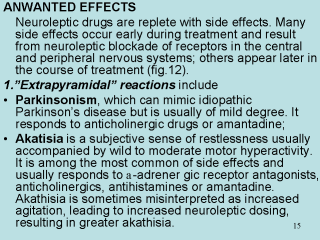 |
Acute
dystonic reactions are involuntary movements (muscle spasms, protruding tongue,
torticollis, etc.), usually appear within a few days of starting neuroleptic treatment and
can appear as oculogyric crisis (dystonic posturing of neck, face, and eyes) or
combination of focal dystonias. They are frightening but also very responsive to injected
anticholinergic or antihistamine drugs. They do not tend to recur during neuroleptic
treatment. These tree reactions occur commonly in the first few weeks, often declining
with time, and they are reversible on stopping drug treatment. The occurrence of acute
dystonias is consistent with block of DA-nergic nigrostriatal pathway.
Tardive dyskinesia develops after months or years in 20-40% of patients treated
with classical antipsychotic drugs, and is one of the main problems of antipsychotic
therapy. It characterized by involuntary and excessive oral-facial movements. Sever
tardive dyskinesia can cause feeding and breathing to be impaired as well as be
disfiguring. There are several theories about the mechanism of tardive dyskinesia. One
is that it is associated with a gradual increase in the number or hypersensitivity of D2
receptor sites in striatum (up-regulation), which is less marked with the atypical
antipsychotic drugs. Another possibility is that chronic block of inhibitory D2-receptors
enchances catecholamones and/or glutamate release in the striatum, leading to excitotoxic
neurodegeneration. |
